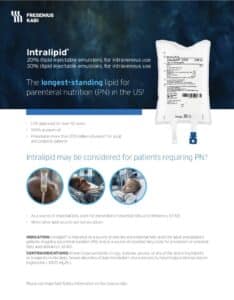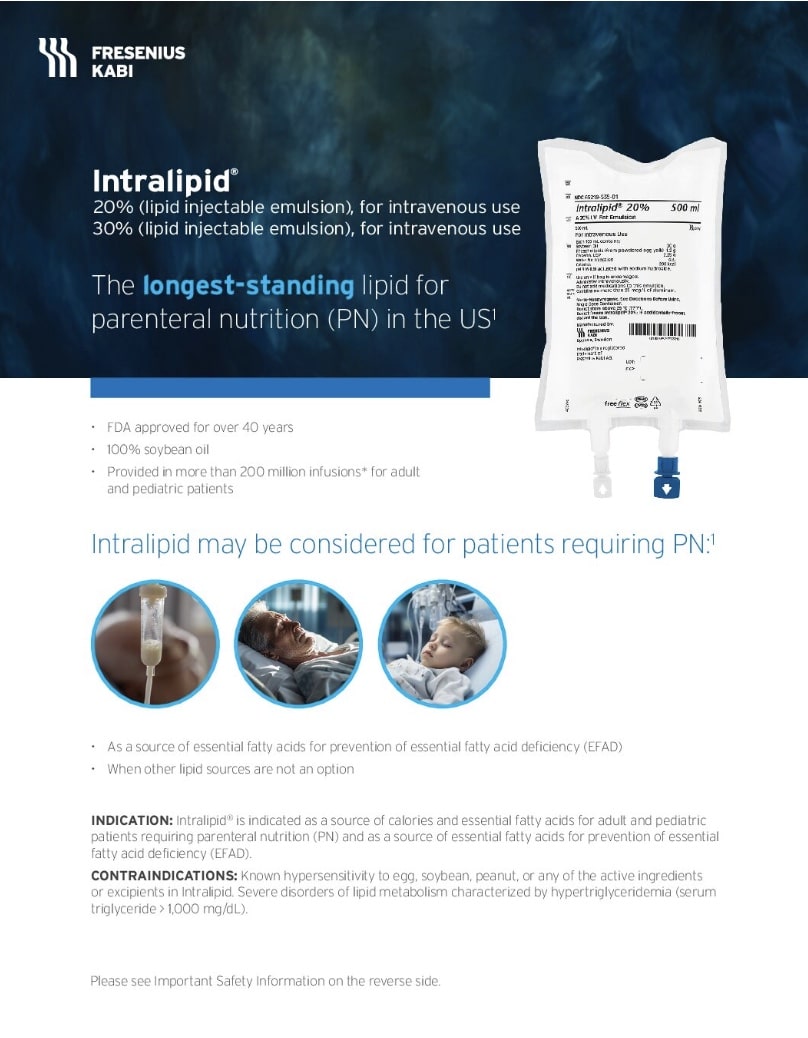
Intralipid: The longest-standing lipid for parenteral nutrition (PN) in the US1

A time—honored lipid emulsion
A long-standing and chosen lipid worldwide: 100% soybean oil–based Intralipid has been administered in more than 200 million infusions since its European approval in 1962.*
Established source of calories and essential fatty acids (EFAs)1: Intralipid contains the EFAs linoleic acid (44% to 62%) and alpha-linolenic acid (4% to 11%).1
*Data on file.
Intralipid 20% composition1
| Intralipid 20% | Content per L | Content per mL |
|---|---|---|
| Soybean oil (g) | 200 | 0.2 |
| Osmolality (mOsm/kg water) | 350 | 0.35 |
| Inorganic phosphate (mmol) | 15 | 0.15 |
| Total caloric value (kcal) | 2000 | 2 |

Intralipid nourishes with 100% soybean oil1:
- As a source of essential fatty acids for prevention of essential fatty acid deficiency
- When other lipid sources are not an option
- For inpatient use in both adults and children

It is recommended that the standard intake of nonprotein energy in PN from dextrose be 70%–85% and 15%–30% from lipid.2
Indication and contraindications
INDICATION: Intralipid is indicated as a source of calories and essential fatty acids for adult and pediatric patients requiring parenteral nutrition (PN) and as a source of essential fatty acids for prevention of essential fatty acid deficiency (EFAD).1
CONTRAINDICATIONS: Known hypersensitivity to egg, soybean, peanut, or any of the active or inactive ingredients in Intralipid. Severe disorders of lipid metabolism characterized by hypertriglyceridemia (serum triglyceride > 1,000 mg/dL).1
*Intralipid Pharmacy Bulk Package is only indicated for use in pharmacy admixture program for the preparation of three-in-one or total nutrient admixtures.1
Intralipid resources
Explore additional Intralipid materials by visiting our Resource Center.
For Consumers
Intralipid (lipid injectable emulsion) for intravenous use
IMPORTANT SAFETY INFORMATION
What is Intralipid?
- Indicated as a source of calories and essential fatty acids for adult and pediatric patients requiring parenteral nutrition (PN) and as a source of essential fatty acids for prevention of essential fatty acid deficiency (EFAD).
Intralipid should not be received by patients who have:
- A known allergy to egg, soybean, or peanut, or any of the active ingredients or excipients in Intralipid.
- Abnormally high levels of lipid (triglycerides) in the blood.
Intralipid may cause serious side effects including:
- Serious Adverse Reactions with Rapid Infusion of Intravenous Lipid Emulsion in Neonates and Infants: Strictly adhere to the recommended total daily dosage and do not exceed the maximum infusion rate. If poor clearance of fats occurs, the infusion should be stopped, and a medical evaluation started.
- Risk of Parenteral Nutrition-Associated Liver Disease: Parenteral nutrition-associated liver disease (PNALD) may progress to liver inflammation and damage caused by a buildup of fat in the liver with scarring and cirrhosis.
- Allergic Reactions: Contact your healthcare provider immediately if you are experiencing an allergic reaction.
- Fat Overload Syndrome, Refeeding Syndrome, Elevated Triglycerides: Your healthcare provider will monitor you for signs and symptoms of early infection and blood levels
For Consumers
Intralipid (lipid injectable emulsion) for intravenous use
IMPORTANT SAFETY INFORMATION
What is Intralipid?
- Indicated as a source of calories and essential fatty acids for adult and pediatric patients requiring parenteral nutrition (PN) and as a source of essential fatty acids for prevention of essential fatty acid deficiency (EFAD).
Intralipid should not be received by patients who have:
- A known allergy to egg, soybean, or peanut, or any of the active ingredients or excipients in Intralipid.
- Abnormally high levels of lipid (triglycerides) in the blood.
Intralipid may cause serious side effects including:
- Serious Adverse Reactions with Rapid Infusion of Intravenous Lipid Emulsion in Neonates and Infants: Strictly adhere to the recommended total daily dosage and do not exceed the maximum infusion rate. If poor clearance of fats occurs, the infusion should be stopped, and a medical evaluation started.
- Risk of Parenteral Nutrition-Associated Liver Disease: Parenteral nutrition-associated liver disease (PNALD) may progress to liver inflammation and damage caused by a buildup of fat in the liver with scarring and cirrhosis.
- Allergic Reactions: Contact your healthcare provider immediately if you are experiencing an allergic reaction.
- Fat Overload Syndrome, Refeeding Syndrome, Elevated Triglycerides: Your healthcare provider will monitor you for signs and symptoms of early infection and blood levels
